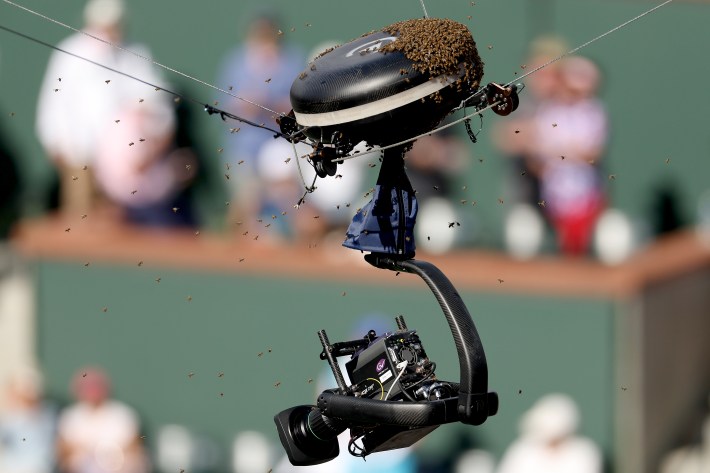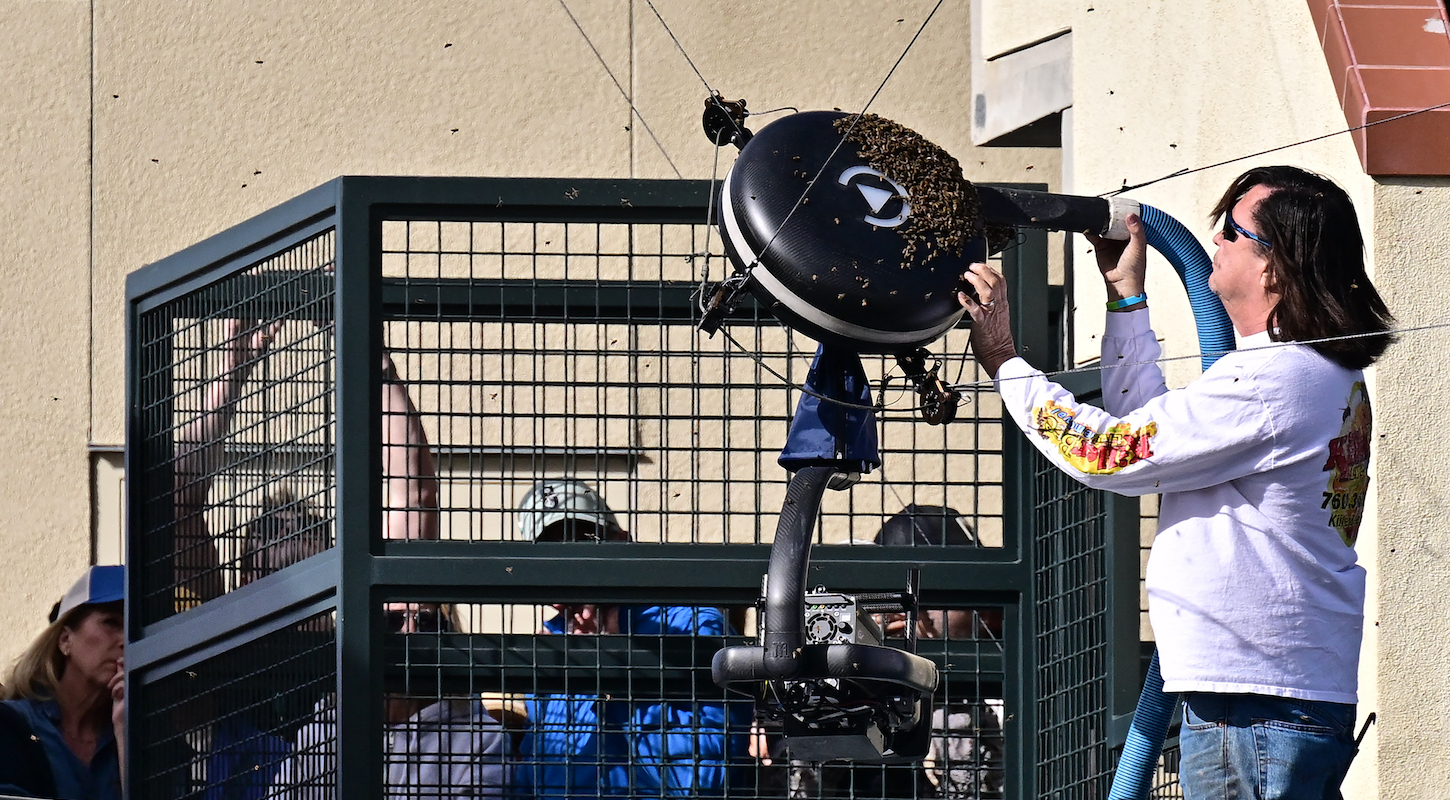The bees descended onto the court one point into the third game of the Indian Wells quarterfinal between Carlos Alcaraz and Alexander Zverev. We first noticed the swarm hovering near the upper deck a few minutes before they arrived at court level. They targeted Alcaraz first, and he scurried to the umpire; Zverev flattened himself against the back wall of the court. Both players fled—Alcaraz's agent confirmed that Carlitos was stung on the forehead—and play was halted while the intruders were addressed. Some fans left their seats, but we can report that an unfazed Bill Gates remained in his box.
An absolutely staggering number of bees had gathered on the overhead spider camera, which was then retracted to a remote corner of the stadium so that the bees could be safely removed. Defector tennis bureau chief Giri Nathan and correspondent Patrick Redford raced upstairs to watch Lance Davis of Killer Bee Live Removal calmly vacuum the swarm into a small box, thoroughly scour the camera for any loiterers, and even pick up a few stray bees with his hands. After almost two hours, play resumed and Alcaraz sped to a dazzling 6-3, 6-1 win. What follows is a short conversation with Davis.
I just wanted to talk to you a little bit about the bee rescue today.
Yeah, that was a lot of fun. Got it done right. The bees are sitting on the back of my truck right now, in a cage.
That's great to hear. We were very impressed by how quickly you got in and out of there, too. We wanted to ask you what your overall strategy was for dealing with the bees.
Always keeping them alive and safe and saving anybody else around them. So they don't flash like steam and attack somebody, right? And you don't think about it. Because if you think about it, you dwell on it too much. And something bad could happen. So it's good. I just keep on working through it. And eventually I get all the bees.
Do you know what kind of bees these are?
It’s a feral colony. There are some little tiny ones, those are the African ones. And there's some larger ones. So those are the drones, and then the other larger females are just the regular wild colony bees. It's probably a mix. It's a mix blend colony with both African and European, but they are very gentle most of the time. These are very gentle, and they're swarming or dividing the colonies because they're so full of nectar that they bring along with them for the trip.
How did you get so comfortable handling the bees? We noticed you weren't wearing any gloves or any other protection.
Yeah, I haven't done that since about 10 years into the business because you get stung so much you just know what it feels like. You get over it real fast.
Did you get stung today?
Yeah, a couple times on the hand, and one on the cheek.
How long have you been in the business?
I started keeping bees back in 1971. And I've been doing this since 1984.

What's something most people don't know about bees?
They’re the most useful insects to humankind. They pollinate most anything that a herbivore would eat, anything that flowers. And you say, Well, I can eat beef. Well, guess what? Bees pollinate the alfalfa that cattle and sheep and everything else eat. So it's important to sustaining the whole life of the planet.
Yeah, they're very crucial to our ecosystem.
Queen bees lay up to 2,000 eggs a day. The gestation period is 21 days. And then once they get in a place where they can start producing like that, they keep laying eggs 2,000 eggs a day, every 21 days. And queens can live up to five years.
Did you see a queen bee today?
Yes, she's in the cage. That’s why all my other bees are on the outside.
So when you found her, did you recognize that it was the queen as you were vacuuming her up?
I was in really a hurry because I didn't want to dilly-dally, so I didn't grab her, because if I grabbed her then she could fly around and she could go somewhere else, so I just vacuumed her up for safety precautions.
Do you have an estimate for how many bees there were today?
Probably about 2,500 to about 3,000 bees.
Are they just around this time of year because the flowers are blooming?
They're here because they get overcrowded in the wetlands when it rains and such. So when it warms up, it's their way to get the queen together with half the workers and leave.
Do you know why they were attracted to the camera?
That's a good question. Probably because it's dark and it was hanging by itself and the plastic on the camera could have been warmed by the sun. So they felt like they needed to get someplace warm because as you can tell, it's starting to cool down right? It is chilly today. And they're cold-blooded insects. So you know, after about 57 degrees, they get really cold and get lethargic, so they gotta cluster together and vibrate their wings. That's what makes friction, to keep it warm.






